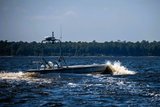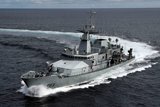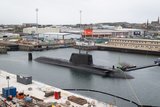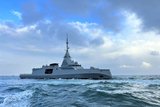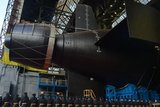Australia commissions HMAS Arafura three-and-a-half years behind schedule
HMAS Arafura sails into HMAS Stirling ahead of its commissioning ceremony on 28 June. (Photo: ADF)
The Royal Australian Navy (RAN) has commissioned the first eponymous Arafura-class OPV at its Western Australia naval base. The milestone, which took place on 28 June, occurred three-and-a-half years behind the schedule originally envisioned.
Ironically, Matt Keogh, Australia’s Minister for Defence Personnel, said: “HMAS Arafura delivers on our plan for Australian workers to build vessels for the fleet faster than Australia has for decades, to ensure the navy has what it needs to secure our national interests at sea.”
Unfortunately, however, the Arafura class has been beset by delays. Considering this is a basic OPV based on a design already
Already have an account? Log in
Want to keep reading this article?
More from Naval Warfare
-
![US and UK to begin Trident II D5 Increment 8 in October 2026]()
US and UK to begin Trident II D5 Increment 8 in October 2026
Trident II D5 Increment 8 will involve improvements to the shipboard navigation subsystem for the US Ohio and Columbia and the UK Dreadnought and Vanguard submarine classes.
-
![What capabilities has the US deployed in the Caribbean and South America to engage “drug boats”?]()
What capabilities has the US deployed in the Caribbean and South America to engage “drug boats”?
The US arsenal includes amphibious assault and littoral combat ships, cutters, destroyers, landing platform docks, a nuclear-powered fast attack submarine, drones, ISR aircraft, helicopters and fighters.
-
![HMS Agamemnon: details of the dive and what the Astute-class signifies for the UK Royal Navy]()
HMS Agamemnon: details of the dive and what the Astute-class signifies for the UK Royal Navy
As HMS Agamemnon moves closer towards joining the UK’s in-service submarine fleet, how does the sixth Astute-class fit into the Royal Navy’s defence strategy?
-
![French Navy frigates to align with Hellenic Navy after Aster missile enhancement]()
French Navy frigates to align with Hellenic Navy after Aster missile enhancement
The FDI frigates will have an enhanced warfare capability that matches the configuration of ships ordered by Greece.
-
![Khabarovsk submarine launch reflects Russia’s nuclear modernisation progress]()
Khabarovsk submarine launch reflects Russia’s nuclear modernisation progress
The nuclear-powered vessel, which could carry the Poseidon autonomous torpedo – dubbed the “doomsday missile” – marks another step forward in Russia’s maritime defence push.









